Effects of US-China Trade War and Brexit Supply Chain Risk 15
VerifiedAdded on 2022/08/23
|15
|4274
|16
AI Summary
Contribute Materials
Your contribution can guide someone’s learning journey. Share your
documents today.
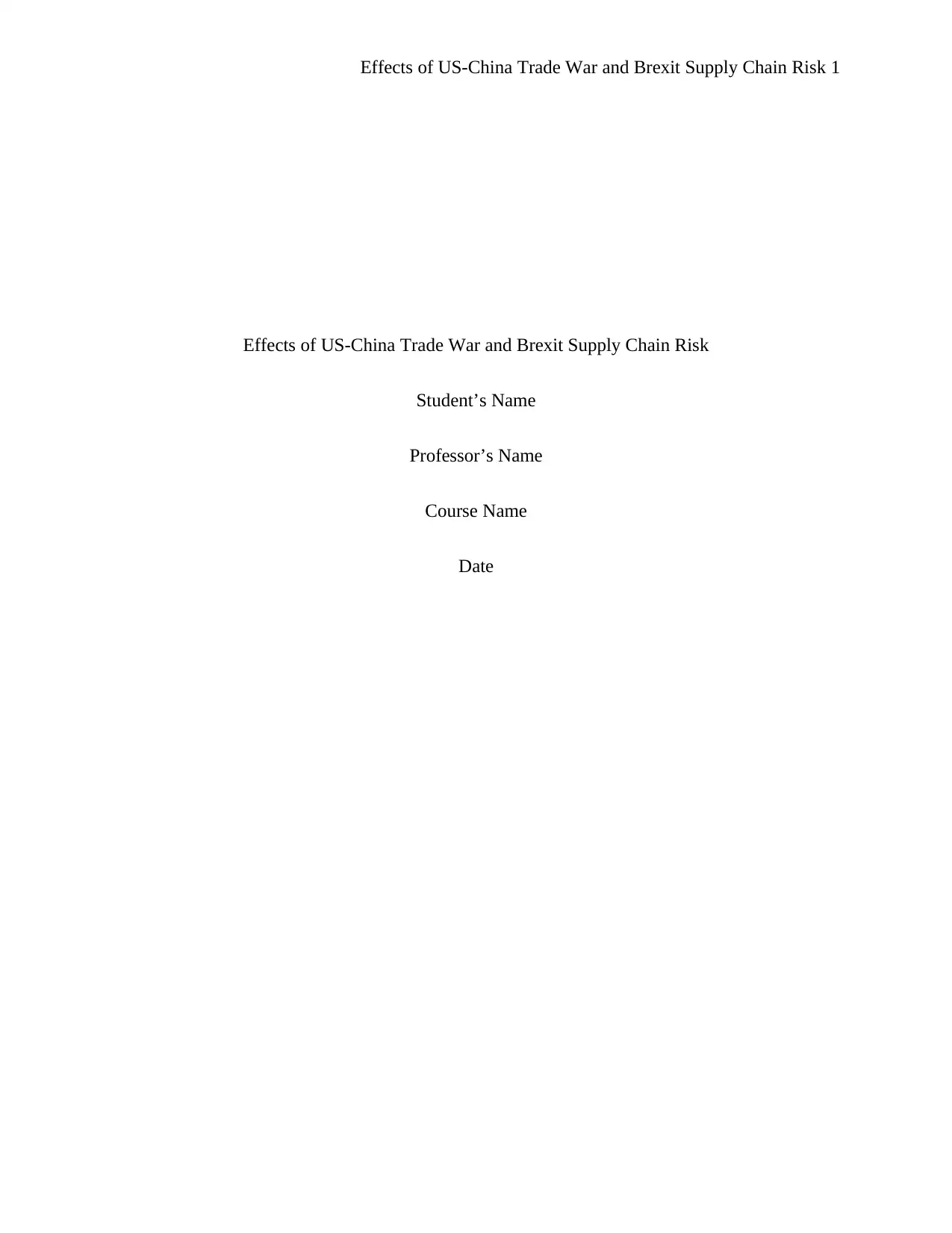
Effects of US-China Trade War and Brexit Supply Chain Risk 1
Effects of US-China Trade War and Brexit Supply Chain Risk
Student’s Name
Professor’s Name
Course Name
Date
Effects of US-China Trade War and Brexit Supply Chain Risk
Student’s Name
Professor’s Name
Course Name
Date
Secure Best Marks with AI Grader
Need help grading? Try our AI Grader for instant feedback on your assignments.
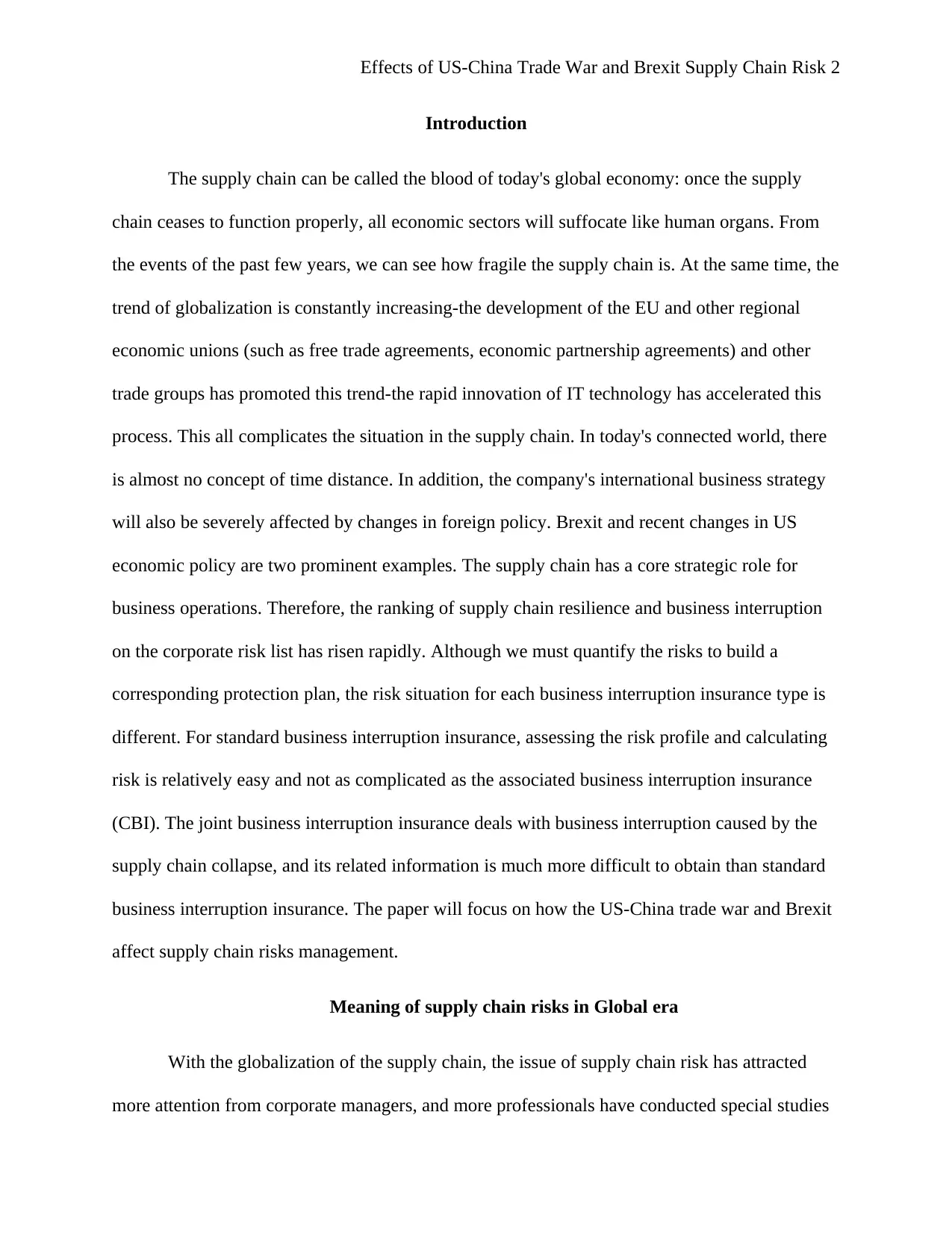
Effects of US-China Trade War and Brexit Supply Chain Risk 2
Introduction
The supply chain can be called the blood of today's global economy: once the supply
chain ceases to function properly, all economic sectors will suffocate like human organs. From
the events of the past few years, we can see how fragile the supply chain is. At the same time, the
trend of globalization is constantly increasing-the development of the EU and other regional
economic unions (such as free trade agreements, economic partnership agreements) and other
trade groups has promoted this trend-the rapid innovation of IT technology has accelerated this
process. This all complicates the situation in the supply chain. In today's connected world, there
is almost no concept of time distance. In addition, the company's international business strategy
will also be severely affected by changes in foreign policy. Brexit and recent changes in US
economic policy are two prominent examples. The supply chain has a core strategic role for
business operations. Therefore, the ranking of supply chain resilience and business interruption
on the corporate risk list has risen rapidly. Although we must quantify the risks to build a
corresponding protection plan, the risk situation for each business interruption insurance type is
different. For standard business interruption insurance, assessing the risk profile and calculating
risk is relatively easy and not as complicated as the associated business interruption insurance
(CBI). The joint business interruption insurance deals with business interruption caused by the
supply chain collapse, and its related information is much more difficult to obtain than standard
business interruption insurance. The paper will focus on how the US-China trade war and Brexit
affect supply chain risks management.
Meaning of supply chain risks in Global era
With the globalization of the supply chain, the issue of supply chain risk has attracted
more attention from corporate managers, and more professionals have conducted special studies
Introduction
The supply chain can be called the blood of today's global economy: once the supply
chain ceases to function properly, all economic sectors will suffocate like human organs. From
the events of the past few years, we can see how fragile the supply chain is. At the same time, the
trend of globalization is constantly increasing-the development of the EU and other regional
economic unions (such as free trade agreements, economic partnership agreements) and other
trade groups has promoted this trend-the rapid innovation of IT technology has accelerated this
process. This all complicates the situation in the supply chain. In today's connected world, there
is almost no concept of time distance. In addition, the company's international business strategy
will also be severely affected by changes in foreign policy. Brexit and recent changes in US
economic policy are two prominent examples. The supply chain has a core strategic role for
business operations. Therefore, the ranking of supply chain resilience and business interruption
on the corporate risk list has risen rapidly. Although we must quantify the risks to build a
corresponding protection plan, the risk situation for each business interruption insurance type is
different. For standard business interruption insurance, assessing the risk profile and calculating
risk is relatively easy and not as complicated as the associated business interruption insurance
(CBI). The joint business interruption insurance deals with business interruption caused by the
supply chain collapse, and its related information is much more difficult to obtain than standard
business interruption insurance. The paper will focus on how the US-China trade war and Brexit
affect supply chain risks management.
Meaning of supply chain risks in Global era
With the globalization of the supply chain, the issue of supply chain risk has attracted
more attention from corporate managers, and more professionals have conducted special studies
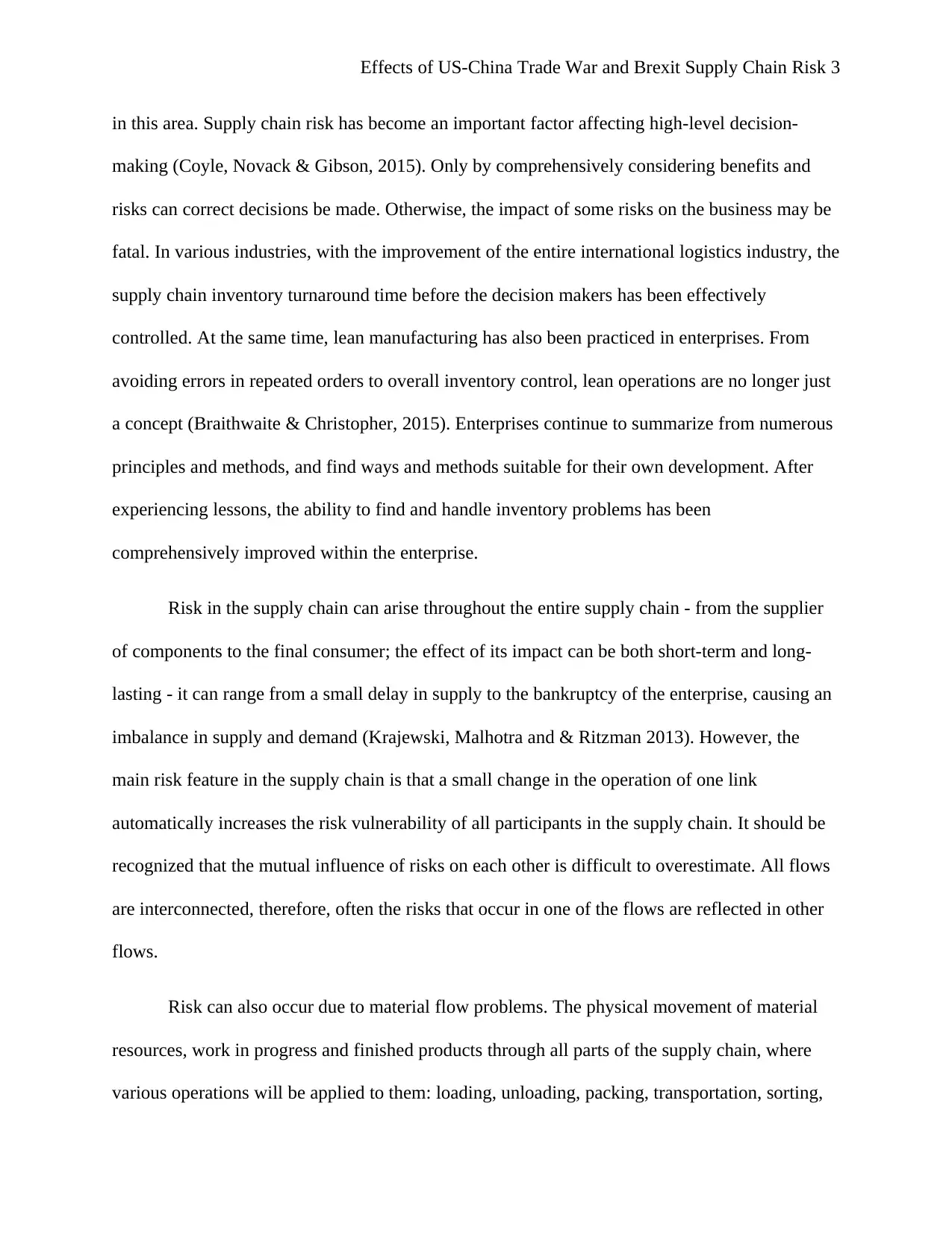
Effects of US-China Trade War and Brexit Supply Chain Risk 3
in this area. Supply chain risk has become an important factor affecting high-level decision-
making (Coyle, Novack & Gibson, 2015). Only by comprehensively considering benefits and
risks can correct decisions be made. Otherwise, the impact of some risks on the business may be
fatal. In various industries, with the improvement of the entire international logistics industry, the
supply chain inventory turnaround time before the decision makers has been effectively
controlled. At the same time, lean manufacturing has also been practiced in enterprises. From
avoiding errors in repeated orders to overall inventory control, lean operations are no longer just
a concept (Braithwaite & Christopher, 2015). Enterprises continue to summarize from numerous
principles and methods, and find ways and methods suitable for their own development. After
experiencing lessons, the ability to find and handle inventory problems has been
comprehensively improved within the enterprise.
Risk in the supply chain can arise throughout the entire supply chain - from the supplier
of components to the final consumer; the effect of its impact can be both short-term and long-
lasting - it can range from a small delay in supply to the bankruptcy of the enterprise, causing an
imbalance in supply and demand (Krajewski, Malhotra and & Ritzman 2013). However, the
main risk feature in the supply chain is that a small change in the operation of one link
automatically increases the risk vulnerability of all participants in the supply chain. It should be
recognized that the mutual influence of risks on each other is difficult to overestimate. All flows
are interconnected, therefore, often the risks that occur in one of the flows are reflected in other
flows.
Risk can also occur due to material flow problems. The physical movement of material
resources, work in progress and finished products through all parts of the supply chain, where
various operations will be applied to them: loading, unloading, packing, transportation, sorting,
in this area. Supply chain risk has become an important factor affecting high-level decision-
making (Coyle, Novack & Gibson, 2015). Only by comprehensively considering benefits and
risks can correct decisions be made. Otherwise, the impact of some risks on the business may be
fatal. In various industries, with the improvement of the entire international logistics industry, the
supply chain inventory turnaround time before the decision makers has been effectively
controlled. At the same time, lean manufacturing has also been practiced in enterprises. From
avoiding errors in repeated orders to overall inventory control, lean operations are no longer just
a concept (Braithwaite & Christopher, 2015). Enterprises continue to summarize from numerous
principles and methods, and find ways and methods suitable for their own development. After
experiencing lessons, the ability to find and handle inventory problems has been
comprehensively improved within the enterprise.
Risk in the supply chain can arise throughout the entire supply chain - from the supplier
of components to the final consumer; the effect of its impact can be both short-term and long-
lasting - it can range from a small delay in supply to the bankruptcy of the enterprise, causing an
imbalance in supply and demand (Krajewski, Malhotra and & Ritzman 2013). However, the
main risk feature in the supply chain is that a small change in the operation of one link
automatically increases the risk vulnerability of all participants in the supply chain. It should be
recognized that the mutual influence of risks on each other is difficult to overestimate. All flows
are interconnected, therefore, often the risks that occur in one of the flows are reflected in other
flows.
Risk can also occur due to material flow problems. The physical movement of material
resources, work in progress and finished products through all parts of the supply chain, where
various operations will be applied to them: loading, unloading, packing, transportation, sorting,
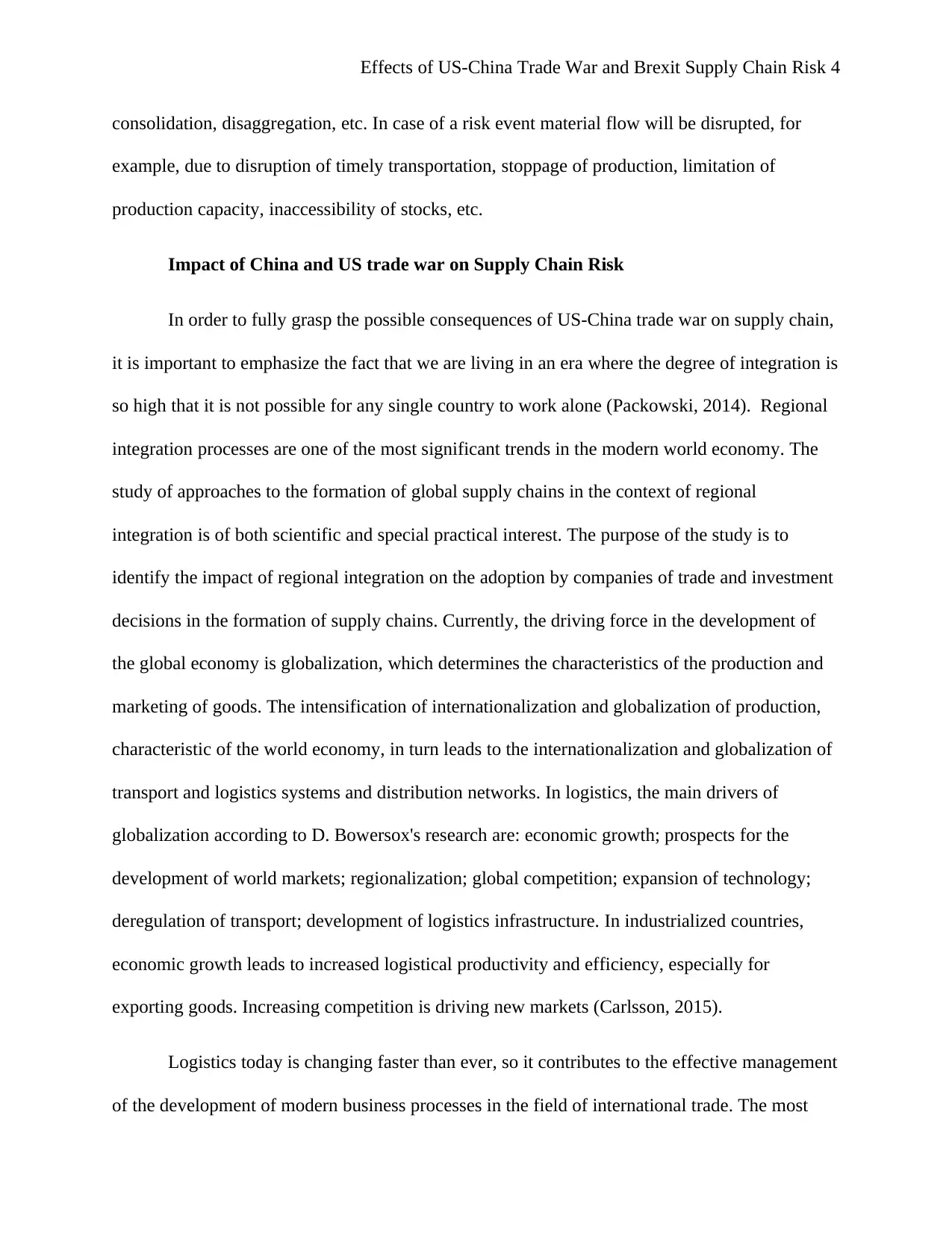
Effects of US-China Trade War and Brexit Supply Chain Risk 4
consolidation, disaggregation, etc. In case of a risk event material flow will be disrupted, for
example, due to disruption of timely transportation, stoppage of production, limitation of
production capacity, inaccessibility of stocks, etc.
Impact of China and US trade war on Supply Chain Risk
In order to fully grasp the possible consequences of US-China trade war on supply chain,
it is important to emphasize the fact that we are living in an era where the degree of integration is
so high that it is not possible for any single country to work alone (Packowski, 2014). Regional
integration processes are one of the most significant trends in the modern world economy. The
study of approaches to the formation of global supply chains in the context of regional
integration is of both scientific and special practical interest. The purpose of the study is to
identify the impact of regional integration on the adoption by companies of trade and investment
decisions in the formation of supply chains. Currently, the driving force in the development of
the global economy is globalization, which determines the characteristics of the production and
marketing of goods. The intensification of internationalization and globalization of production,
characteristic of the world economy, in turn leads to the internationalization and globalization of
transport and logistics systems and distribution networks. In logistics, the main drivers of
globalization according to D. Bowersox's research are: economic growth; prospects for the
development of world markets; regionalization; global competition; expansion of technology;
deregulation of transport; development of logistics infrastructure. In industrialized countries,
economic growth leads to increased logistical productivity and efficiency, especially for
exporting goods. Increasing competition is driving new markets (Carlsson, 2015).
Logistics today is changing faster than ever, so it contributes to the effective management
of the development of modern business processes in the field of international trade. The most
consolidation, disaggregation, etc. In case of a risk event material flow will be disrupted, for
example, due to disruption of timely transportation, stoppage of production, limitation of
production capacity, inaccessibility of stocks, etc.
Impact of China and US trade war on Supply Chain Risk
In order to fully grasp the possible consequences of US-China trade war on supply chain,
it is important to emphasize the fact that we are living in an era where the degree of integration is
so high that it is not possible for any single country to work alone (Packowski, 2014). Regional
integration processes are one of the most significant trends in the modern world economy. The
study of approaches to the formation of global supply chains in the context of regional
integration is of both scientific and special practical interest. The purpose of the study is to
identify the impact of regional integration on the adoption by companies of trade and investment
decisions in the formation of supply chains. Currently, the driving force in the development of
the global economy is globalization, which determines the characteristics of the production and
marketing of goods. The intensification of internationalization and globalization of production,
characteristic of the world economy, in turn leads to the internationalization and globalization of
transport and logistics systems and distribution networks. In logistics, the main drivers of
globalization according to D. Bowersox's research are: economic growth; prospects for the
development of world markets; regionalization; global competition; expansion of technology;
deregulation of transport; development of logistics infrastructure. In industrialized countries,
economic growth leads to increased logistical productivity and efficiency, especially for
exporting goods. Increasing competition is driving new markets (Carlsson, 2015).
Logistics today is changing faster than ever, so it contributes to the effective management
of the development of modern business processes in the field of international trade. The most
Secure Best Marks with AI Grader
Need help grading? Try our AI Grader for instant feedback on your assignments.
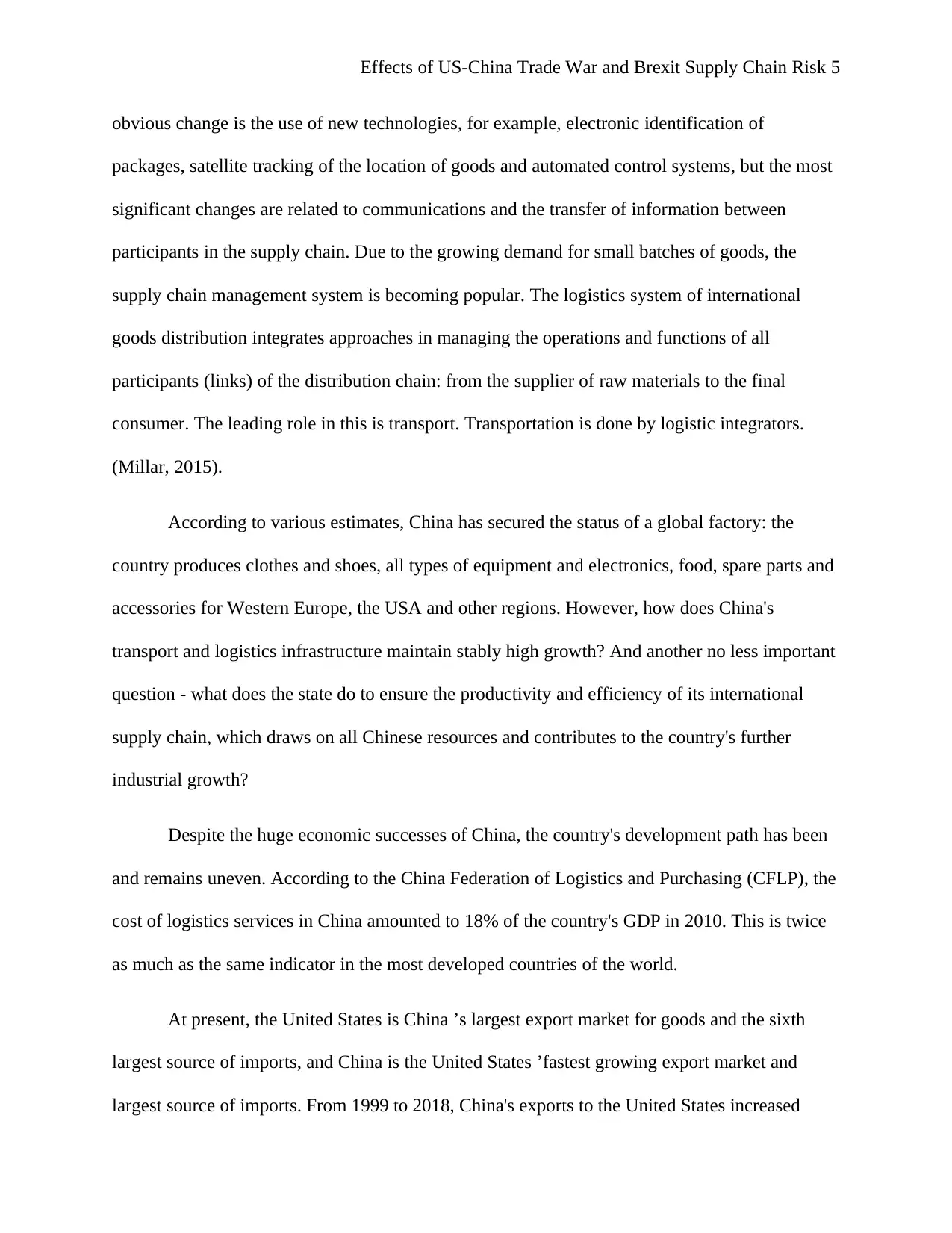
Effects of US-China Trade War and Brexit Supply Chain Risk 5
obvious change is the use of new technologies, for example, electronic identification of
packages, satellite tracking of the location of goods and automated control systems, but the most
significant changes are related to communications and the transfer of information between
participants in the supply chain. Due to the growing demand for small batches of goods, the
supply chain management system is becoming popular. The logistics system of international
goods distribution integrates approaches in managing the operations and functions of all
participants (links) of the distribution chain: from the supplier of raw materials to the final
consumer. The leading role in this is transport. Transportation is done by logistic integrators.
(Millar, 2015).
According to various estimates, China has secured the status of a global factory: the
country produces clothes and shoes, all types of equipment and electronics, food, spare parts and
accessories for Western Europe, the USA and other regions. However, how does China's
transport and logistics infrastructure maintain stably high growth? And another no less important
question - what does the state do to ensure the productivity and efficiency of its international
supply chain, which draws on all Chinese resources and contributes to the country's further
industrial growth?
Despite the huge economic successes of China, the country's development path has been
and remains uneven. According to the China Federation of Logistics and Purchasing (CFLP), the
cost of logistics services in China amounted to 18% of the country's GDP in 2010. This is twice
as much as the same indicator in the most developed countries of the world.
At present, the United States is China ’s largest export market for goods and the sixth
largest source of imports, and China is the United States ’fastest growing export market and
largest source of imports. From 1999 to 2018, China's exports to the United States increased
obvious change is the use of new technologies, for example, electronic identification of
packages, satellite tracking of the location of goods and automated control systems, but the most
significant changes are related to communications and the transfer of information between
participants in the supply chain. Due to the growing demand for small batches of goods, the
supply chain management system is becoming popular. The logistics system of international
goods distribution integrates approaches in managing the operations and functions of all
participants (links) of the distribution chain: from the supplier of raw materials to the final
consumer. The leading role in this is transport. Transportation is done by logistic integrators.
(Millar, 2015).
According to various estimates, China has secured the status of a global factory: the
country produces clothes and shoes, all types of equipment and electronics, food, spare parts and
accessories for Western Europe, the USA and other regions. However, how does China's
transport and logistics infrastructure maintain stably high growth? And another no less important
question - what does the state do to ensure the productivity and efficiency of its international
supply chain, which draws on all Chinese resources and contributes to the country's further
industrial growth?
Despite the huge economic successes of China, the country's development path has been
and remains uneven. According to the China Federation of Logistics and Purchasing (CFLP), the
cost of logistics services in China amounted to 18% of the country's GDP in 2010. This is twice
as much as the same indicator in the most developed countries of the world.
At present, the United States is China ’s largest export market for goods and the sixth
largest source of imports, and China is the United States ’fastest growing export market and
largest source of imports. From 1999 to 2018, China's exports to the United States increased
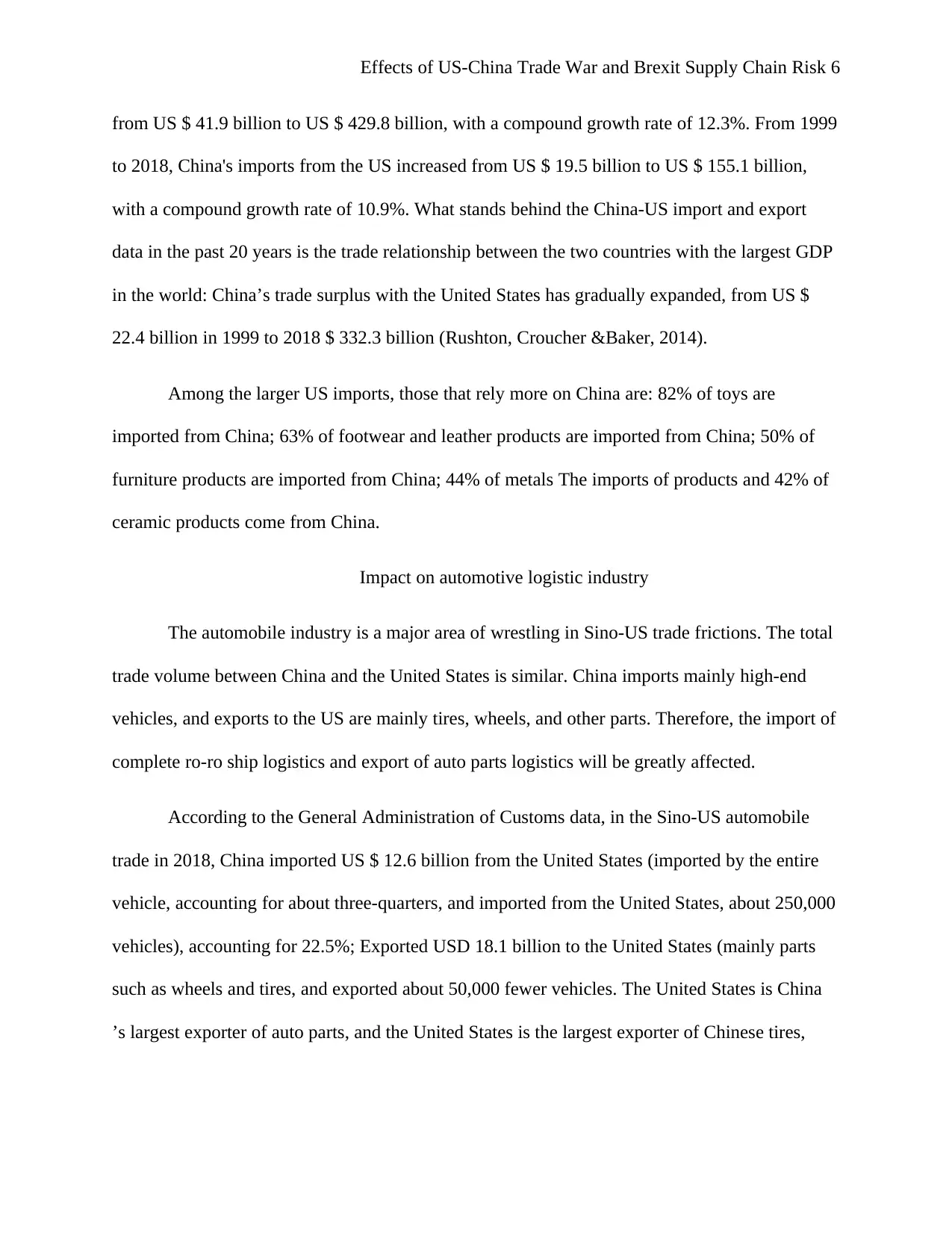
Effects of US-China Trade War and Brexit Supply Chain Risk 6
from US $ 41.9 billion to US $ 429.8 billion, with a compound growth rate of 12.3%. From 1999
to 2018, China's imports from the US increased from US $ 19.5 billion to US $ 155.1 billion,
with a compound growth rate of 10.9%. What stands behind the China-US import and export
data in the past 20 years is the trade relationship between the two countries with the largest GDP
in the world: China’s trade surplus with the United States has gradually expanded, from US $
22.4 billion in 1999 to 2018 $ 332.3 billion (Rushton, Croucher &Baker, 2014).
Among the larger US imports, those that rely more on China are: 82% of toys are
imported from China; 63% of footwear and leather products are imported from China; 50% of
furniture products are imported from China; 44% of metals The imports of products and 42% of
ceramic products come from China.
Impact on automotive logistic industry
The automobile industry is a major area of wrestling in Sino-US trade frictions. The total
trade volume between China and the United States is similar. China imports mainly high-end
vehicles, and exports to the US are mainly tires, wheels, and other parts. Therefore, the import of
complete ro-ro ship logistics and export of auto parts logistics will be greatly affected.
According to the General Administration of Customs data, in the Sino-US automobile
trade in 2018, China imported US $ 12.6 billion from the United States (imported by the entire
vehicle, accounting for about three-quarters, and imported from the United States, about 250,000
vehicles), accounting for 22.5%; Exported USD 18.1 billion to the United States (mainly parts
such as wheels and tires, and exported about 50,000 fewer vehicles. The United States is China
’s largest exporter of auto parts, and the United States is the largest exporter of Chinese tires,
from US $ 41.9 billion to US $ 429.8 billion, with a compound growth rate of 12.3%. From 1999
to 2018, China's imports from the US increased from US $ 19.5 billion to US $ 155.1 billion,
with a compound growth rate of 10.9%. What stands behind the China-US import and export
data in the past 20 years is the trade relationship between the two countries with the largest GDP
in the world: China’s trade surplus with the United States has gradually expanded, from US $
22.4 billion in 1999 to 2018 $ 332.3 billion (Rushton, Croucher &Baker, 2014).
Among the larger US imports, those that rely more on China are: 82% of toys are
imported from China; 63% of footwear and leather products are imported from China; 50% of
furniture products are imported from China; 44% of metals The imports of products and 42% of
ceramic products come from China.
Impact on automotive logistic industry
The automobile industry is a major area of wrestling in Sino-US trade frictions. The total
trade volume between China and the United States is similar. China imports mainly high-end
vehicles, and exports to the US are mainly tires, wheels, and other parts. Therefore, the import of
complete ro-ro ship logistics and export of auto parts logistics will be greatly affected.
According to the General Administration of Customs data, in the Sino-US automobile
trade in 2018, China imported US $ 12.6 billion from the United States (imported by the entire
vehicle, accounting for about three-quarters, and imported from the United States, about 250,000
vehicles), accounting for 22.5%; Exported USD 18.1 billion to the United States (mainly parts
such as wheels and tires, and exported about 50,000 fewer vehicles. The United States is China
’s largest exporter of auto parts, and the United States is the largest exporter of Chinese tires,
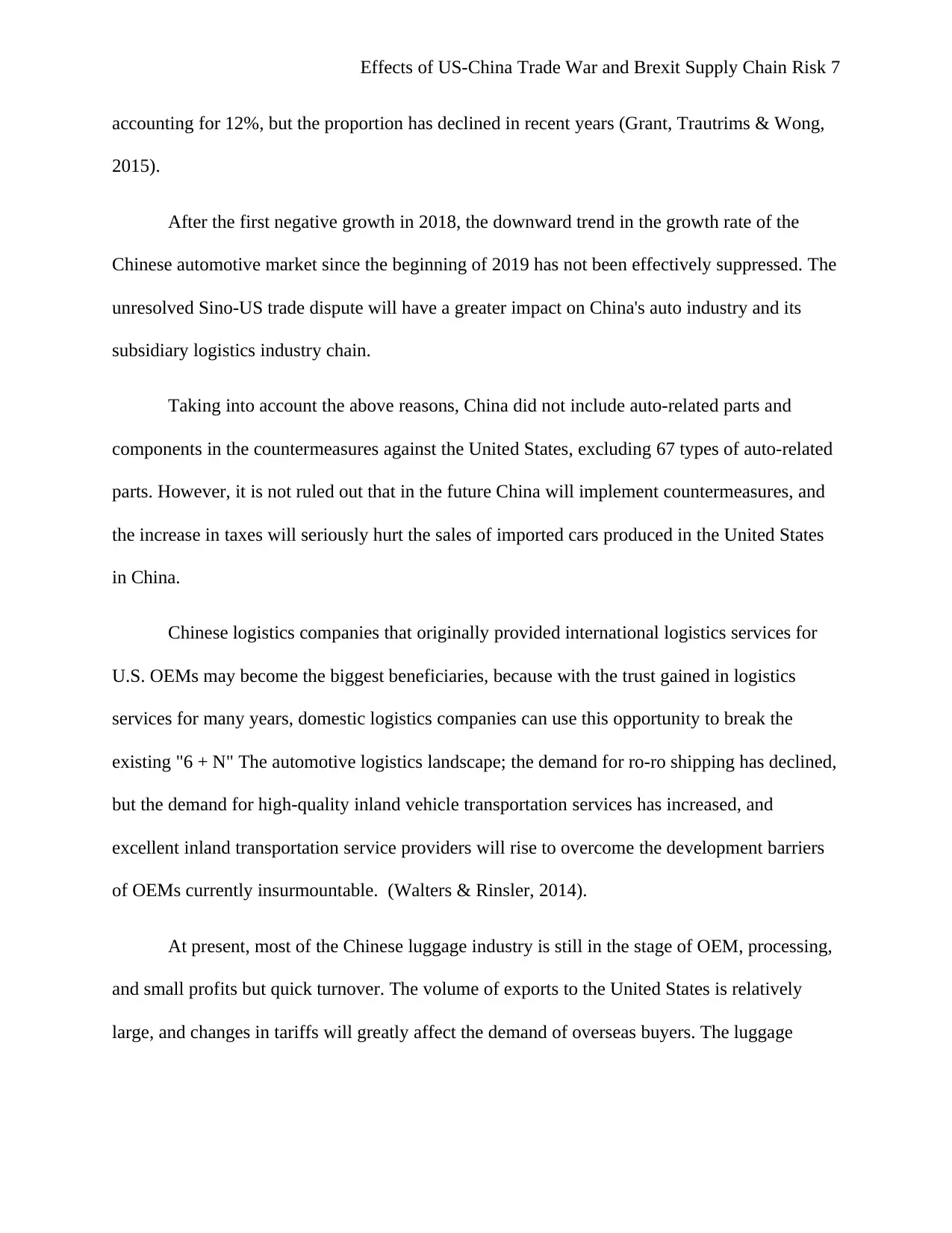
Effects of US-China Trade War and Brexit Supply Chain Risk 7
accounting for 12%, but the proportion has declined in recent years (Grant, Trautrims & Wong,
2015).
After the first negative growth in 2018, the downward trend in the growth rate of the
Chinese automotive market since the beginning of 2019 has not been effectively suppressed. The
unresolved Sino-US trade dispute will have a greater impact on China's auto industry and its
subsidiary logistics industry chain.
Taking into account the above reasons, China did not include auto-related parts and
components in the countermeasures against the United States, excluding 67 types of auto-related
parts. However, it is not ruled out that in the future China will implement countermeasures, and
the increase in taxes will seriously hurt the sales of imported cars produced in the United States
in China.
Chinese logistics companies that originally provided international logistics services for
U.S. OEMs may become the biggest beneficiaries, because with the trust gained in logistics
services for many years, domestic logistics companies can use this opportunity to break the
existing "6 + N" The automotive logistics landscape; the demand for ro-ro shipping has declined,
but the demand for high-quality inland vehicle transportation services has increased, and
excellent inland transportation service providers will rise to overcome the development barriers
of OEMs currently insurmountable. (Walters & Rinsler, 2014).
At present, most of the Chinese luggage industry is still in the stage of OEM, processing,
and small profits but quick turnover. The volume of exports to the United States is relatively
large, and changes in tariffs will greatly affect the demand of overseas buyers. The luggage
accounting for 12%, but the proportion has declined in recent years (Grant, Trautrims & Wong,
2015).
After the first negative growth in 2018, the downward trend in the growth rate of the
Chinese automotive market since the beginning of 2019 has not been effectively suppressed. The
unresolved Sino-US trade dispute will have a greater impact on China's auto industry and its
subsidiary logistics industry chain.
Taking into account the above reasons, China did not include auto-related parts and
components in the countermeasures against the United States, excluding 67 types of auto-related
parts. However, it is not ruled out that in the future China will implement countermeasures, and
the increase in taxes will seriously hurt the sales of imported cars produced in the United States
in China.
Chinese logistics companies that originally provided international logistics services for
U.S. OEMs may become the biggest beneficiaries, because with the trust gained in logistics
services for many years, domestic logistics companies can use this opportunity to break the
existing "6 + N" The automotive logistics landscape; the demand for ro-ro shipping has declined,
but the demand for high-quality inland vehicle transportation services has increased, and
excellent inland transportation service providers will rise to overcome the development barriers
of OEMs currently insurmountable. (Walters & Rinsler, 2014).
At present, most of the Chinese luggage industry is still in the stage of OEM, processing,
and small profits but quick turnover. The volume of exports to the United States is relatively
large, and changes in tariffs will greatly affect the demand of overseas buyers. The luggage
Paraphrase This Document
Need a fresh take? Get an instant paraphrase of this document with our AI Paraphraser
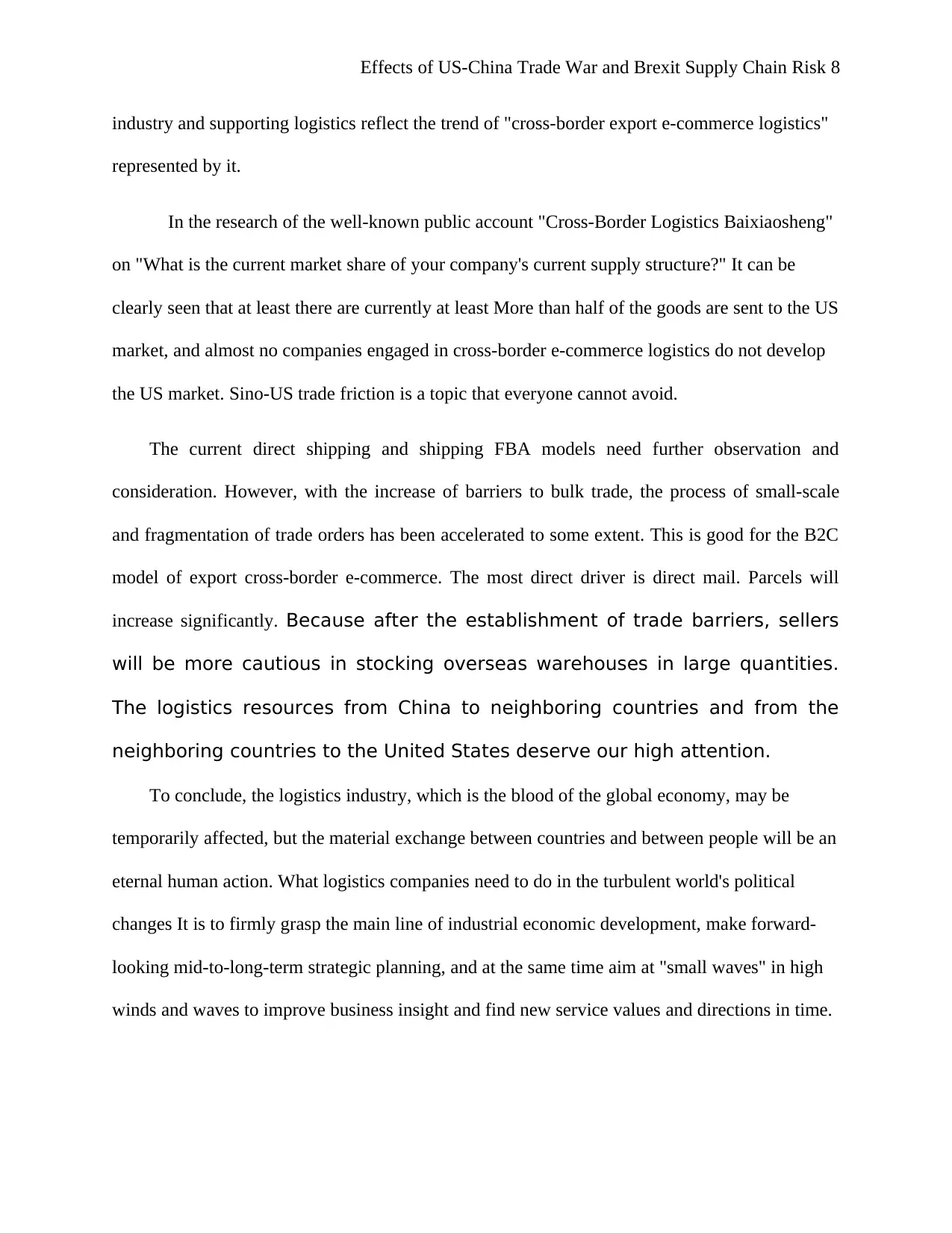
Effects of US-China Trade War and Brexit Supply Chain Risk 8
industry and supporting logistics reflect the trend of "cross-border export e-commerce logistics"
represented by it.
In the research of the well-known public account "Cross-Border Logistics Baixiaosheng"
on "What is the current market share of your company's current supply structure?" It can be
clearly seen that at least there are currently at least More than half of the goods are sent to the US
market, and almost no companies engaged in cross-border e-commerce logistics do not develop
the US market. Sino-US trade friction is a topic that everyone cannot avoid.
The current direct shipping and shipping FBA models need further observation and
consideration. However, with the increase of barriers to bulk trade, the process of small-scale
and fragmentation of trade orders has been accelerated to some extent. This is good for the B2C
model of export cross-border e-commerce. The most direct driver is direct mail. Parcels will
increase significantly. Because after the establishment of trade barriers, sellers
will be more cautious in stocking overseas warehouses in large quantities.
The logistics resources from China to neighboring countries and from the
neighboring countries to the United States deserve our high attention.
To conclude, the logistics industry, which is the blood of the global economy, may be
temporarily affected, but the material exchange between countries and between people will be an
eternal human action. What logistics companies need to do in the turbulent world's political
changes It is to firmly grasp the main line of industrial economic development, make forward-
looking mid-to-long-term strategic planning, and at the same time aim at "small waves" in high
winds and waves to improve business insight and find new service values and directions in time.
industry and supporting logistics reflect the trend of "cross-border export e-commerce logistics"
represented by it.
In the research of the well-known public account "Cross-Border Logistics Baixiaosheng"
on "What is the current market share of your company's current supply structure?" It can be
clearly seen that at least there are currently at least More than half of the goods are sent to the US
market, and almost no companies engaged in cross-border e-commerce logistics do not develop
the US market. Sino-US trade friction is a topic that everyone cannot avoid.
The current direct shipping and shipping FBA models need further observation and
consideration. However, with the increase of barriers to bulk trade, the process of small-scale
and fragmentation of trade orders has been accelerated to some extent. This is good for the B2C
model of export cross-border e-commerce. The most direct driver is direct mail. Parcels will
increase significantly. Because after the establishment of trade barriers, sellers
will be more cautious in stocking overseas warehouses in large quantities.
The logistics resources from China to neighboring countries and from the
neighboring countries to the United States deserve our high attention.
To conclude, the logistics industry, which is the blood of the global economy, may be
temporarily affected, but the material exchange between countries and between people will be an
eternal human action. What logistics companies need to do in the turbulent world's political
changes It is to firmly grasp the main line of industrial economic development, make forward-
looking mid-to-long-term strategic planning, and at the same time aim at "small waves" in high
winds and waves to improve business insight and find new service values and directions in time.
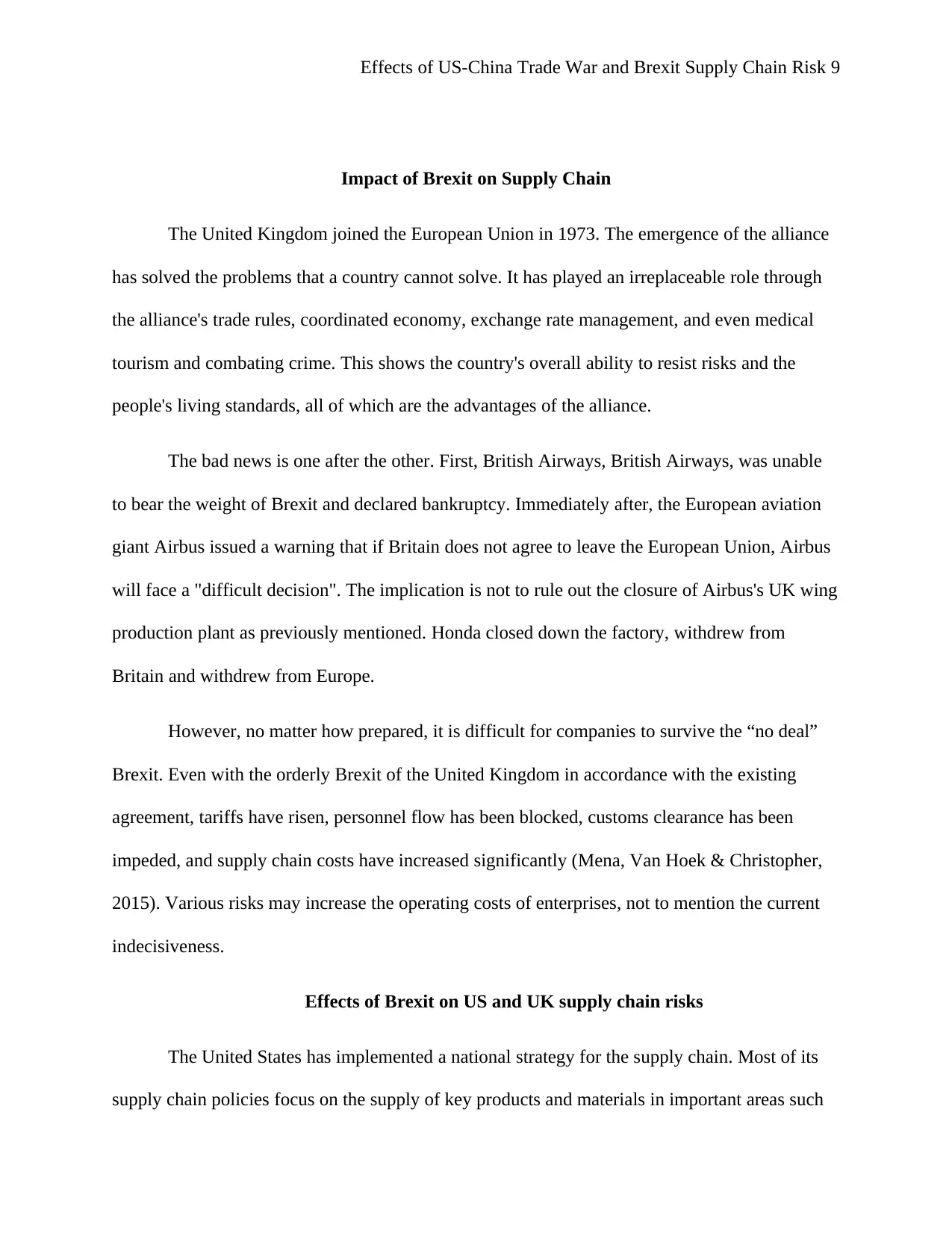
Effects of US-China Trade War and Brexit Supply Chain Risk 9
Impact of Brexit on Supply Chain
The United Kingdom joined the European Union in 1973. The emergence of the alliance
has solved the problems that a country cannot solve. It has played an irreplaceable role through
the alliance's trade rules, coordinated economy, exchange rate management, and even medical
tourism and combating crime. This shows the country's overall ability to resist risks and the
people's living standards, all of which are the advantages of the alliance.
The bad news is one after the other. First, British Airways, British Airways, was unable
to bear the weight of Brexit and declared bankruptcy. Immediately after, the European aviation
giant Airbus issued a warning that if Britain does not agree to leave the European Union, Airbus
will face a "difficult decision". The implication is not to rule out the closure of Airbus's UK wing
production plant as previously mentioned. Honda closed down the factory, withdrew from
Britain and withdrew from Europe.
However, no matter how prepared, it is difficult for companies to survive the “no deal”
Brexit. Even with the orderly Brexit of the United Kingdom in accordance with the existing
agreement, tariffs have risen, personnel flow has been blocked, customs clearance has been
impeded, and supply chain costs have increased significantly (Mena, Van Hoek & Christopher,
2015). Various risks may increase the operating costs of enterprises, not to mention the current
indecisiveness.
Effects of Brexit on US and UK supply chain risks
The United States has implemented a national strategy for the supply chain. Most of its
supply chain policies focus on the supply of key products and materials in important areas such
Impact of Brexit on Supply Chain
The United Kingdom joined the European Union in 1973. The emergence of the alliance
has solved the problems that a country cannot solve. It has played an irreplaceable role through
the alliance's trade rules, coordinated economy, exchange rate management, and even medical
tourism and combating crime. This shows the country's overall ability to resist risks and the
people's living standards, all of which are the advantages of the alliance.
The bad news is one after the other. First, British Airways, British Airways, was unable
to bear the weight of Brexit and declared bankruptcy. Immediately after, the European aviation
giant Airbus issued a warning that if Britain does not agree to leave the European Union, Airbus
will face a "difficult decision". The implication is not to rule out the closure of Airbus's UK wing
production plant as previously mentioned. Honda closed down the factory, withdrew from
Britain and withdrew from Europe.
However, no matter how prepared, it is difficult for companies to survive the “no deal”
Brexit. Even with the orderly Brexit of the United Kingdom in accordance with the existing
agreement, tariffs have risen, personnel flow has been blocked, customs clearance has been
impeded, and supply chain costs have increased significantly (Mena, Van Hoek & Christopher,
2015). Various risks may increase the operating costs of enterprises, not to mention the current
indecisiveness.
Effects of Brexit on US and UK supply chain risks
The United States has implemented a national strategy for the supply chain. Most of its
supply chain policies focus on the supply of key products and materials in important areas such
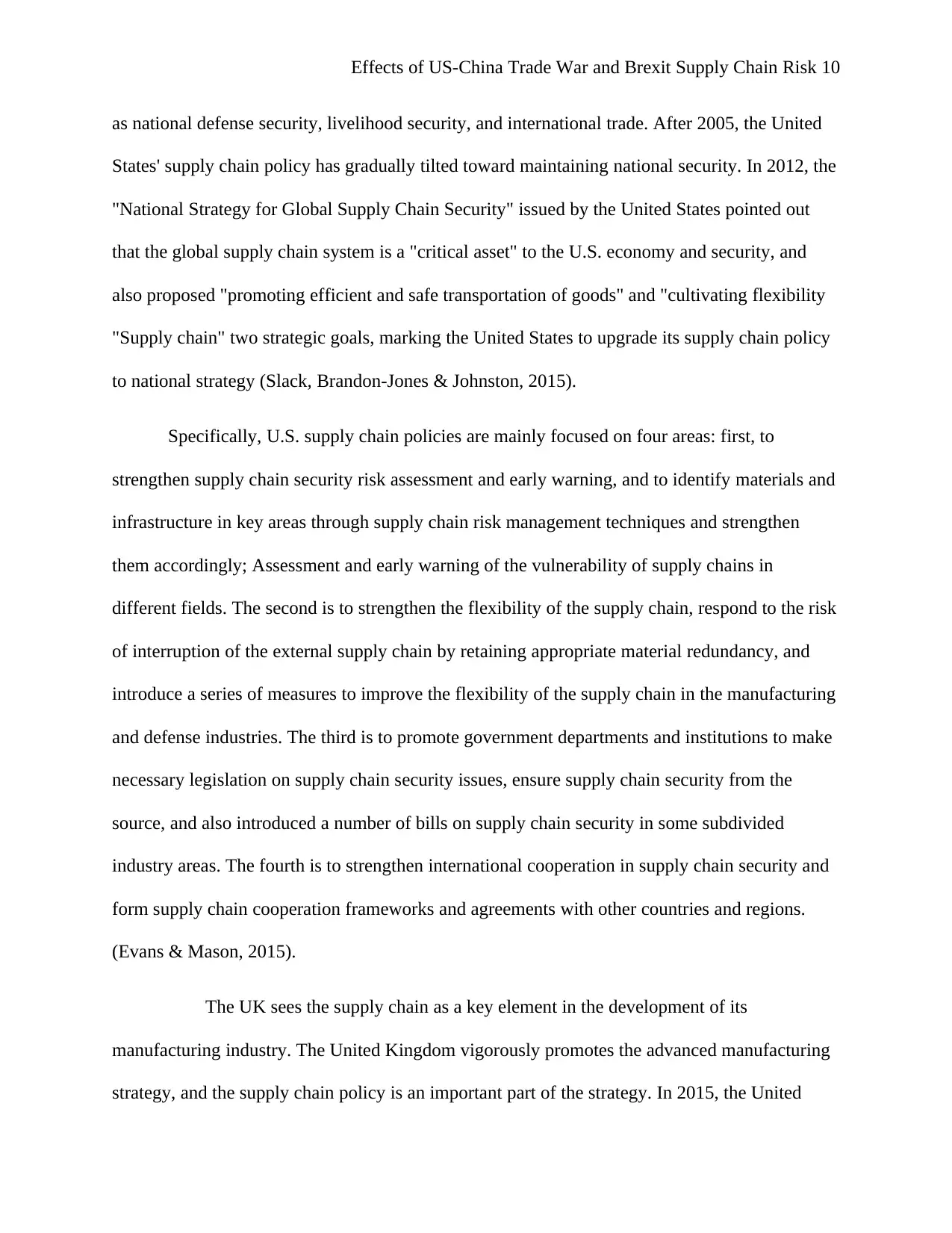
Effects of US-China Trade War and Brexit Supply Chain Risk 10
as national defense security, livelihood security, and international trade. After 2005, the United
States' supply chain policy has gradually tilted toward maintaining national security. In 2012, the
"National Strategy for Global Supply Chain Security" issued by the United States pointed out
that the global supply chain system is a "critical asset" to the U.S. economy and security, and
also proposed "promoting efficient and safe transportation of goods" and "cultivating flexibility
"Supply chain" two strategic goals, marking the United States to upgrade its supply chain policy
to national strategy (Slack, Brandon-Jones & Johnston, 2015).
Specifically, U.S. supply chain policies are mainly focused on four areas: first, to
strengthen supply chain security risk assessment and early warning, and to identify materials and
infrastructure in key areas through supply chain risk management techniques and strengthen
them accordingly; Assessment and early warning of the vulnerability of supply chains in
different fields. The second is to strengthen the flexibility of the supply chain, respond to the risk
of interruption of the external supply chain by retaining appropriate material redundancy, and
introduce a series of measures to improve the flexibility of the supply chain in the manufacturing
and defense industries. The third is to promote government departments and institutions to make
necessary legislation on supply chain security issues, ensure supply chain security from the
source, and also introduced a number of bills on supply chain security in some subdivided
industry areas. The fourth is to strengthen international cooperation in supply chain security and
form supply chain cooperation frameworks and agreements with other countries and regions.
(Evans & Mason, 2015).
The UK sees the supply chain as a key element in the development of its
manufacturing industry. The United Kingdom vigorously promotes the advanced manufacturing
strategy, and the supply chain policy is an important part of the strategy. In 2015, the United
as national defense security, livelihood security, and international trade. After 2005, the United
States' supply chain policy has gradually tilted toward maintaining national security. In 2012, the
"National Strategy for Global Supply Chain Security" issued by the United States pointed out
that the global supply chain system is a "critical asset" to the U.S. economy and security, and
also proposed "promoting efficient and safe transportation of goods" and "cultivating flexibility
"Supply chain" two strategic goals, marking the United States to upgrade its supply chain policy
to national strategy (Slack, Brandon-Jones & Johnston, 2015).
Specifically, U.S. supply chain policies are mainly focused on four areas: first, to
strengthen supply chain security risk assessment and early warning, and to identify materials and
infrastructure in key areas through supply chain risk management techniques and strengthen
them accordingly; Assessment and early warning of the vulnerability of supply chains in
different fields. The second is to strengthen the flexibility of the supply chain, respond to the risk
of interruption of the external supply chain by retaining appropriate material redundancy, and
introduce a series of measures to improve the flexibility of the supply chain in the manufacturing
and defense industries. The third is to promote government departments and institutions to make
necessary legislation on supply chain security issues, ensure supply chain security from the
source, and also introduced a number of bills on supply chain security in some subdivided
industry areas. The fourth is to strengthen international cooperation in supply chain security and
form supply chain cooperation frameworks and agreements with other countries and regions.
(Evans & Mason, 2015).
The UK sees the supply chain as a key element in the development of its
manufacturing industry. The United Kingdom vigorously promotes the advanced manufacturing
strategy, and the supply chain policy is an important part of the strategy. In 2015, the United
Secure Best Marks with AI Grader
Need help grading? Try our AI Grader for instant feedback on your assignments.
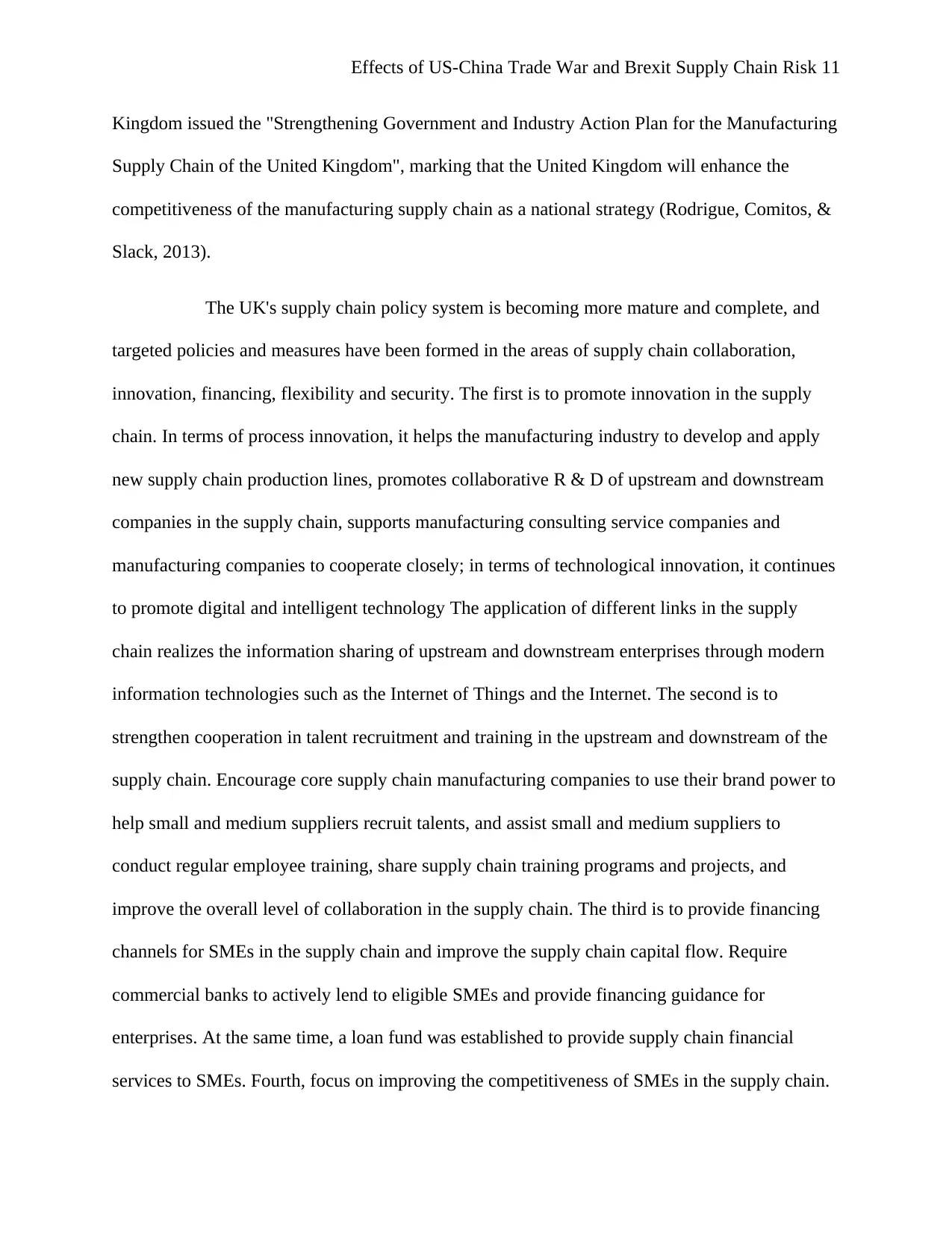
Effects of US-China Trade War and Brexit Supply Chain Risk 11
Kingdom issued the "Strengthening Government and Industry Action Plan for the Manufacturing
Supply Chain of the United Kingdom", marking that the United Kingdom will enhance the
competitiveness of the manufacturing supply chain as a national strategy (Rodrigue, Comitos, &
Slack, 2013).
The UK's supply chain policy system is becoming more mature and complete, and
targeted policies and measures have been formed in the areas of supply chain collaboration,
innovation, financing, flexibility and security. The first is to promote innovation in the supply
chain. In terms of process innovation, it helps the manufacturing industry to develop and apply
new supply chain production lines, promotes collaborative R & D of upstream and downstream
companies in the supply chain, supports manufacturing consulting service companies and
manufacturing companies to cooperate closely; in terms of technological innovation, it continues
to promote digital and intelligent technology The application of different links in the supply
chain realizes the information sharing of upstream and downstream enterprises through modern
information technologies such as the Internet of Things and the Internet. The second is to
strengthen cooperation in talent recruitment and training in the upstream and downstream of the
supply chain. Encourage core supply chain manufacturing companies to use their brand power to
help small and medium suppliers recruit talents, and assist small and medium suppliers to
conduct regular employee training, share supply chain training programs and projects, and
improve the overall level of collaboration in the supply chain. The third is to provide financing
channels for SMEs in the supply chain and improve the supply chain capital flow. Require
commercial banks to actively lend to eligible SMEs and provide financing guidance for
enterprises. At the same time, a loan fund was established to provide supply chain financial
services to SMEs. Fourth, focus on improving the competitiveness of SMEs in the supply chain.
Kingdom issued the "Strengthening Government and Industry Action Plan for the Manufacturing
Supply Chain of the United Kingdom", marking that the United Kingdom will enhance the
competitiveness of the manufacturing supply chain as a national strategy (Rodrigue, Comitos, &
Slack, 2013).
The UK's supply chain policy system is becoming more mature and complete, and
targeted policies and measures have been formed in the areas of supply chain collaboration,
innovation, financing, flexibility and security. The first is to promote innovation in the supply
chain. In terms of process innovation, it helps the manufacturing industry to develop and apply
new supply chain production lines, promotes collaborative R & D of upstream and downstream
companies in the supply chain, supports manufacturing consulting service companies and
manufacturing companies to cooperate closely; in terms of technological innovation, it continues
to promote digital and intelligent technology The application of different links in the supply
chain realizes the information sharing of upstream and downstream enterprises through modern
information technologies such as the Internet of Things and the Internet. The second is to
strengthen cooperation in talent recruitment and training in the upstream and downstream of the
supply chain. Encourage core supply chain manufacturing companies to use their brand power to
help small and medium suppliers recruit talents, and assist small and medium suppliers to
conduct regular employee training, share supply chain training programs and projects, and
improve the overall level of collaboration in the supply chain. The third is to provide financing
channels for SMEs in the supply chain and improve the supply chain capital flow. Require
commercial banks to actively lend to eligible SMEs and provide financing guidance for
enterprises. At the same time, a loan fund was established to provide supply chain financial
services to SMEs. Fourth, focus on improving the competitiveness of SMEs in the supply chain.
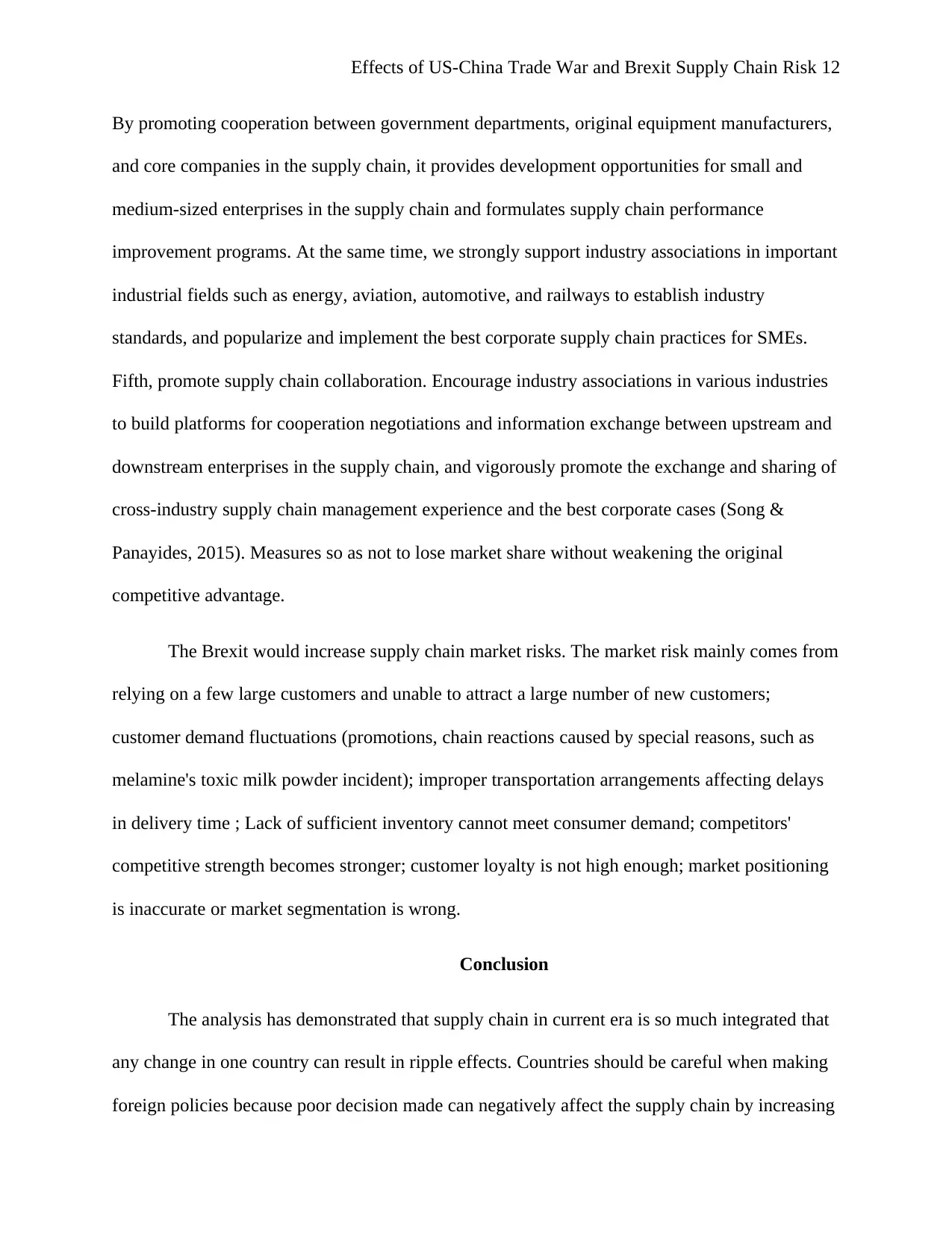
Effects of US-China Trade War and Brexit Supply Chain Risk 12
By promoting cooperation between government departments, original equipment manufacturers,
and core companies in the supply chain, it provides development opportunities for small and
medium-sized enterprises in the supply chain and formulates supply chain performance
improvement programs. At the same time, we strongly support industry associations in important
industrial fields such as energy, aviation, automotive, and railways to establish industry
standards, and popularize and implement the best corporate supply chain practices for SMEs.
Fifth, promote supply chain collaboration. Encourage industry associations in various industries
to build platforms for cooperation negotiations and information exchange between upstream and
downstream enterprises in the supply chain, and vigorously promote the exchange and sharing of
cross-industry supply chain management experience and the best corporate cases (Song &
Panayides, 2015). Measures so as not to lose market share without weakening the original
competitive advantage.
The Brexit would increase supply chain market risks. The market risk mainly comes from
relying on a few large customers and unable to attract a large number of new customers;
customer demand fluctuations (promotions, chain reactions caused by special reasons, such as
melamine's toxic milk powder incident); improper transportation arrangements affecting delays
in delivery time ; Lack of sufficient inventory cannot meet consumer demand; competitors'
competitive strength becomes stronger; customer loyalty is not high enough; market positioning
is inaccurate or market segmentation is wrong.
Conclusion
The analysis has demonstrated that supply chain in current era is so much integrated that
any change in one country can result in ripple effects. Countries should be careful when making
foreign policies because poor decision made can negatively affect the supply chain by increasing
By promoting cooperation between government departments, original equipment manufacturers,
and core companies in the supply chain, it provides development opportunities for small and
medium-sized enterprises in the supply chain and formulates supply chain performance
improvement programs. At the same time, we strongly support industry associations in important
industrial fields such as energy, aviation, automotive, and railways to establish industry
standards, and popularize and implement the best corporate supply chain practices for SMEs.
Fifth, promote supply chain collaboration. Encourage industry associations in various industries
to build platforms for cooperation negotiations and information exchange between upstream and
downstream enterprises in the supply chain, and vigorously promote the exchange and sharing of
cross-industry supply chain management experience and the best corporate cases (Song &
Panayides, 2015). Measures so as not to lose market share without weakening the original
competitive advantage.
The Brexit would increase supply chain market risks. The market risk mainly comes from
relying on a few large customers and unable to attract a large number of new customers;
customer demand fluctuations (promotions, chain reactions caused by special reasons, such as
melamine's toxic milk powder incident); improper transportation arrangements affecting delays
in delivery time ; Lack of sufficient inventory cannot meet consumer demand; competitors'
competitive strength becomes stronger; customer loyalty is not high enough; market positioning
is inaccurate or market segmentation is wrong.
Conclusion
The analysis has demonstrated that supply chain in current era is so much integrated that
any change in one country can result in ripple effects. Countries should be careful when making
foreign policies because poor decision made can negatively affect the supply chain by increasing
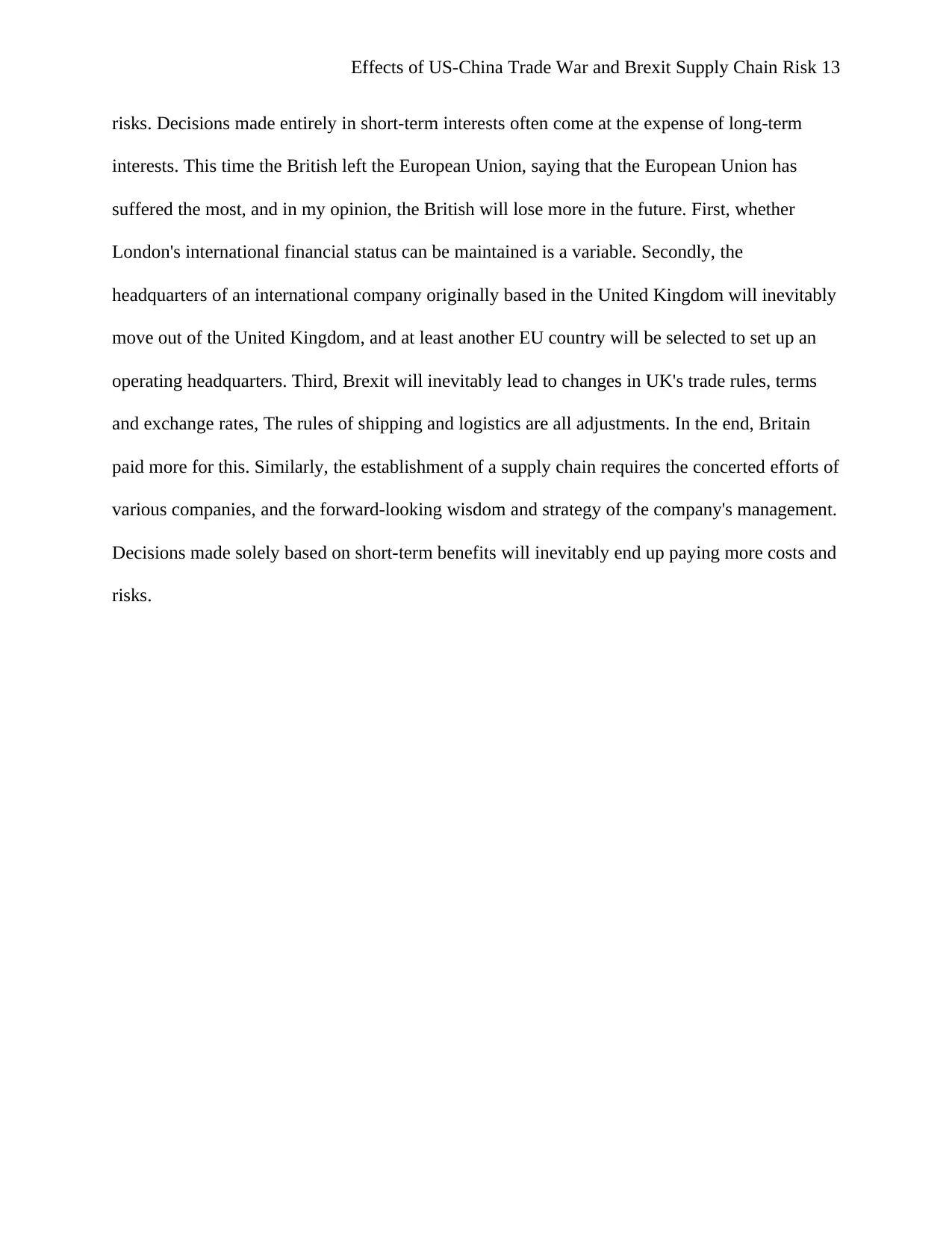
Effects of US-China Trade War and Brexit Supply Chain Risk 13
risks. Decisions made entirely in short-term interests often come at the expense of long-term
interests. This time the British left the European Union, saying that the European Union has
suffered the most, and in my opinion, the British will lose more in the future. First, whether
London's international financial status can be maintained is a variable. Secondly, the
headquarters of an international company originally based in the United Kingdom will inevitably
move out of the United Kingdom, and at least another EU country will be selected to set up an
operating headquarters. Third, Brexit will inevitably lead to changes in UK's trade rules, terms
and exchange rates, The rules of shipping and logistics are all adjustments. In the end, Britain
paid more for this. Similarly, the establishment of a supply chain requires the concerted efforts of
various companies, and the forward-looking wisdom and strategy of the company's management.
Decisions made solely based on short-term benefits will inevitably end up paying more costs and
risks.
risks. Decisions made entirely in short-term interests often come at the expense of long-term
interests. This time the British left the European Union, saying that the European Union has
suffered the most, and in my opinion, the British will lose more in the future. First, whether
London's international financial status can be maintained is a variable. Secondly, the
headquarters of an international company originally based in the United Kingdom will inevitably
move out of the United Kingdom, and at least another EU country will be selected to set up an
operating headquarters. Third, Brexit will inevitably lead to changes in UK's trade rules, terms
and exchange rates, The rules of shipping and logistics are all adjustments. In the end, Britain
paid more for this. Similarly, the establishment of a supply chain requires the concerted efforts of
various companies, and the forward-looking wisdom and strategy of the company's management.
Decisions made solely based on short-term benefits will inevitably end up paying more costs and
risks.
Paraphrase This Document
Need a fresh take? Get an instant paraphrase of this document with our AI Paraphraser
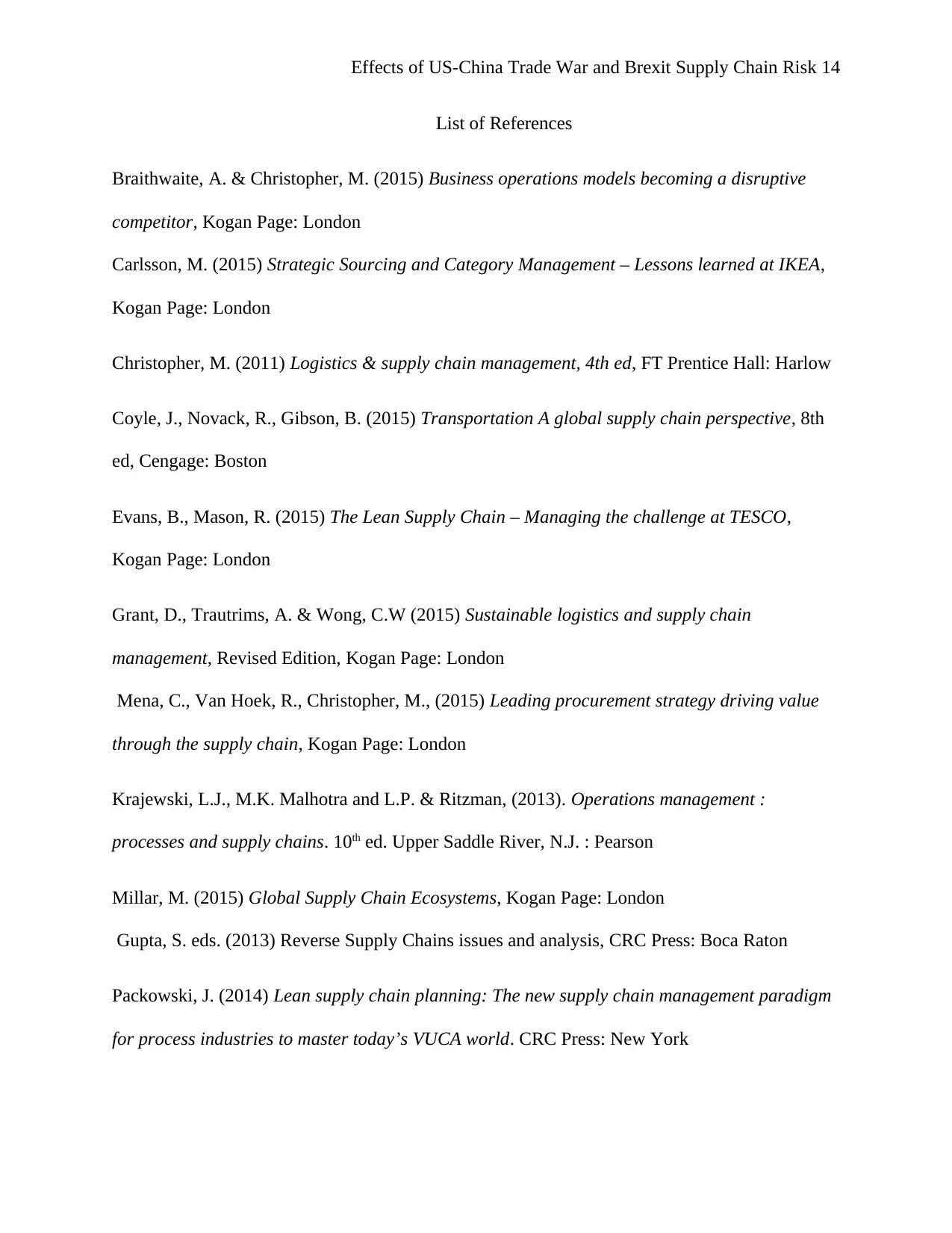
Effects of US-China Trade War and Brexit Supply Chain Risk 14
List of References
Braithwaite, A. & Christopher, M. (2015) Business operations models becoming a disruptive
competitor, Kogan Page: London
Carlsson, M. (2015) Strategic Sourcing and Category Management – Lessons learned at IKEA,
Kogan Page: London
Christopher, M. (2011) Logistics & supply chain management, 4th ed, FT Prentice Hall: Harlow
Coyle, J., Novack, R., Gibson, B. (2015) Transportation A global supply chain perspective, 8th
ed, Cengage: Boston
Evans, B., Mason, R. (2015) The Lean Supply Chain – Managing the challenge at TESCO,
Kogan Page: London
Grant, D., Trautrims, A. & Wong, C.W (2015) Sustainable logistics and supply chain
management, Revised Edition, Kogan Page: London
Mena, C., Van Hoek, R., Christopher, M., (2015) Leading procurement strategy driving value
through the supply chain, Kogan Page: London
Krajewski, L.J., M.K. Malhotra and L.P. & Ritzman, (2013). Operations management :
processes and supply chains. 10th ed. Upper Saddle River, N.J. : Pearson
Millar, M. (2015) Global Supply Chain Ecosystems, Kogan Page: London
Gupta, S. eds. (2013) Reverse Supply Chains issues and analysis, CRC Press: Boca Raton
Packowski, J. (2014) Lean supply chain planning: The new supply chain management paradigm
for process industries to master today’s VUCA world. CRC Press: New York
List of References
Braithwaite, A. & Christopher, M. (2015) Business operations models becoming a disruptive
competitor, Kogan Page: London
Carlsson, M. (2015) Strategic Sourcing and Category Management – Lessons learned at IKEA,
Kogan Page: London
Christopher, M. (2011) Logistics & supply chain management, 4th ed, FT Prentice Hall: Harlow
Coyle, J., Novack, R., Gibson, B. (2015) Transportation A global supply chain perspective, 8th
ed, Cengage: Boston
Evans, B., Mason, R. (2015) The Lean Supply Chain – Managing the challenge at TESCO,
Kogan Page: London
Grant, D., Trautrims, A. & Wong, C.W (2015) Sustainable logistics and supply chain
management, Revised Edition, Kogan Page: London
Mena, C., Van Hoek, R., Christopher, M., (2015) Leading procurement strategy driving value
through the supply chain, Kogan Page: London
Krajewski, L.J., M.K. Malhotra and L.P. & Ritzman, (2013). Operations management :
processes and supply chains. 10th ed. Upper Saddle River, N.J. : Pearson
Millar, M. (2015) Global Supply Chain Ecosystems, Kogan Page: London
Gupta, S. eds. (2013) Reverse Supply Chains issues and analysis, CRC Press: Boca Raton
Packowski, J. (2014) Lean supply chain planning: The new supply chain management paradigm
for process industries to master today’s VUCA world. CRC Press: New York
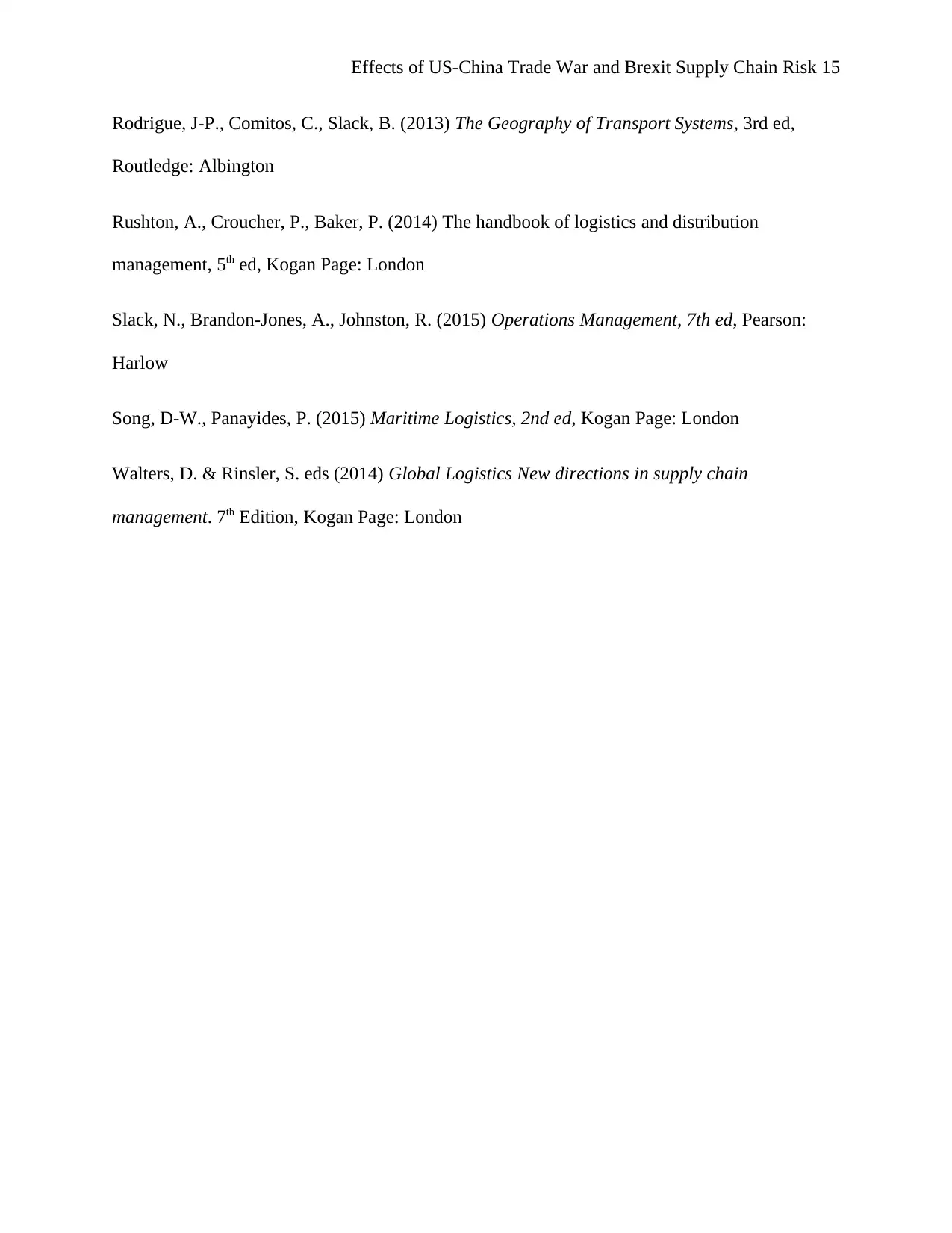
Effects of US-China Trade War and Brexit Supply Chain Risk 15
Rodrigue, J-P., Comitos, C., Slack, B. (2013) The Geography of Transport Systems, 3rd ed,
Routledge: Albington
Rushton, A., Croucher, P., Baker, P. (2014) The handbook of logistics and distribution
management, 5th ed, Kogan Page: London
Slack, N., Brandon-Jones, A., Johnston, R. (2015) Operations Management, 7th ed, Pearson:
Harlow
Song, D-W., Panayides, P. (2015) Maritime Logistics, 2nd ed, Kogan Page: London
Walters, D. & Rinsler, S. eds (2014) Global Logistics New directions in supply chain
management. 7th Edition, Kogan Page: London
Rodrigue, J-P., Comitos, C., Slack, B. (2013) The Geography of Transport Systems, 3rd ed,
Routledge: Albington
Rushton, A., Croucher, P., Baker, P. (2014) The handbook of logistics and distribution
management, 5th ed, Kogan Page: London
Slack, N., Brandon-Jones, A., Johnston, R. (2015) Operations Management, 7th ed, Pearson:
Harlow
Song, D-W., Panayides, P. (2015) Maritime Logistics, 2nd ed, Kogan Page: London
Walters, D. & Rinsler, S. eds (2014) Global Logistics New directions in supply chain
management. 7th Edition, Kogan Page: London
1 out of 15
Related Documents
Your All-in-One AI-Powered Toolkit for Academic Success.
+13062052269
info@desklib.com
Available 24*7 on WhatsApp / Email
![[object Object]](/_next/static/media/star-bottom.7253800d.svg)
Unlock your academic potential
© 2024 | Zucol Services PVT LTD | All rights reserved.





